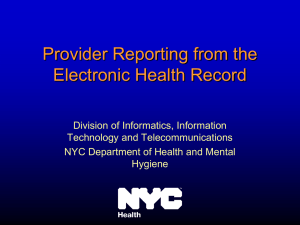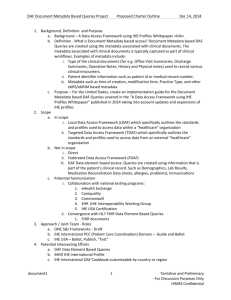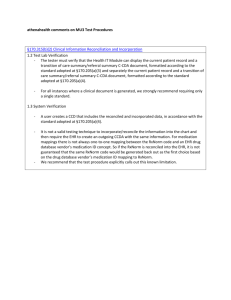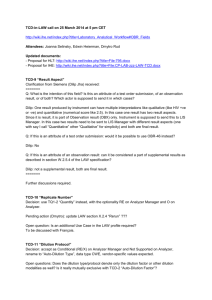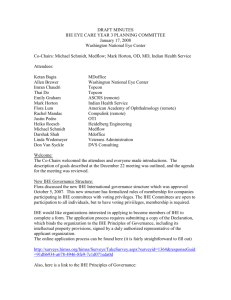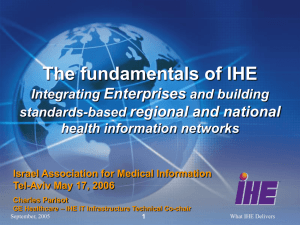Whitepaper
advertisement
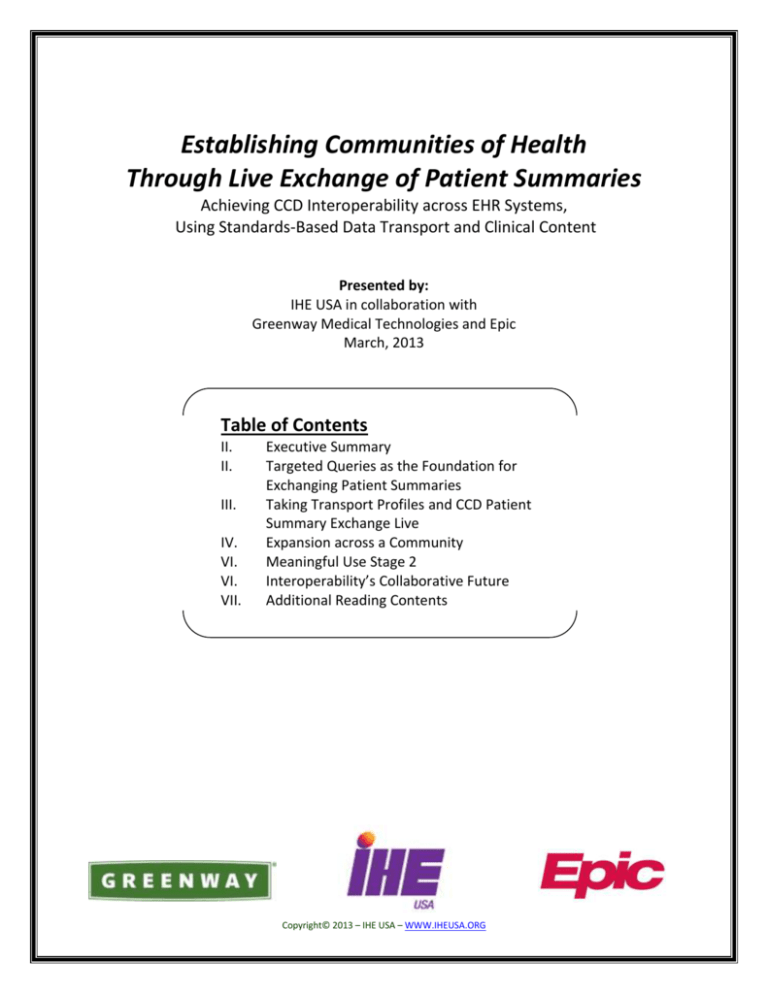
Establishing Communities of Health Through Live Exchange of Patient Summaries Achieving CCD Interoperability across EHR Systems, Using Standards-Based Data Transport and Clinical Content Presented by: IHE USA in collaboration with Greenway Medical Technologies and Epic March, 2013 Table of Contents II. II. III. IV. VI. VI. VII. Executive Summary Targeted Queries as the Foundation for Exchanging Patient Summaries Taking Transport Profiles and CCD Patient Summary Exchange Live Expansion across a Community Meaningful Use Stage 2 Interoperability’s Collaborative Future Additional Reading Contents Copyright© 2013 – IHE USA – WWW.IHEUSA.ORG Establishing Communities of Health Through Live Exchange of Patient Summaries Achieving CCD Interoperability across EHR Systems, Using Standards-Based Data Transport and Clinical Content Executive Summary The healthcare industry has long held the goal of aligning seamless data transport mechanisms with readable clinical content to establish scalable coordinated care. Within that overall goal has been the focus on patient summaries as the foundation of standards-based clinical content that can affect and advance patient care. The emergence of the Continuity of Care Document (CCD) as that summary of care standard has been brought into increased focus by the passage of the HITECH Act and the launch of the meaningful use program. Coupled with efforts to standardize data transport, national and global organizations have collaborated through harmonization and consolidation projects to set a successful and flexible interoperability roadmap. In this paper, we examine one such project, in which live CCD exchange occurs at scale between a hospital and group practice using separate EHR systems from different EHR developers. Targeted Queries as the Foundation for Exchanging Patient Summaries Integrating the Healthcare Enterprise (IHE) defines profiles to coordinate care among players within a healthcare community. Using these profiles, two EHR software developers – Greenway Medical Technologies and Epic – worked with specialty and hospital-based healthcare delivery organizations to create a successful bi-directional query-and-retrieve model that has been operational since September 2012. “This effort is in alignment with the vision of IHE USA, which is to improve the quality, value, and safety of healthcare by enabling rapid, scalable, and secure access to health information at the point of care,” said Joyce Sensmeier, MS, RN-BC, CPHIMS, FHIMSS, FAAN, president, IHE USA. This scalable model demonstrates not only the intra-community information exchange emphasis of Meaningful Use Stage 2, but also a path to achieve the benefits that accountable care, patient-centered medical home and other emerging value-based models can realize. Going forward, the model will become more robust with the emergence of Consolidated Clinical Document Architecture (C-CDA) as a single-source library of reusable templates to construct clinical documents such as CCD, which is also established as an emphasis of Meaningful Use Stage 2 and beyond. Copyright© 2013 – IHE USA – WWW.IHEUSA.ORG This implementation is the product of standards construction, harmonization and testing by national and international organizations, an influx of initiatives by the Office of the National Coordinator for Health Information Technology (ONC), and by the various healthcare delivery organizations placing the standards into live clinical settings. Taking Transport Profiles and CCD Patient Summary Exchange Live In March of 2012, Lancaster General Health System and Doctors May-Grant & Associates began their collaboration to advance care coordination and realize the foundational exchange goals of Stage 2. The project involves the 600-bed Lancaster General Health System (Lancaster, PA) of acute, rehabilitative and labor/delivery hospitals using Epic technology, and Doctors May-Grant & Associates (Lancaster), a six-location Ob/Gyn practice of 15 physicians and 18 midwife/nursing staff utilizing the Greenway platform to provide the full spectrum of Ob/Gyn services, vaccines, ultrasound and osteoporosis screenings and treatment. This collaboration uses IHE profiles for patient discovery and for the query and retrieval of patient summary CCDs, currently comprised of: - Advance Directives Allergies Current Medications Immunizations Insurance Information Last Filed Vitals Prior three-month Encounters (including discharge notes if applicable) Problem List Recent Procedures (within last three months) Recent Lab Results (within last three months) In this implementation, when a woman presents to the hospital in labor, the hospital’s EHR sends a query to match the patient’s record at the clinic practice. The clinic’s EHR automatically evaluates the query, and sends a match (if verified) in response. Upon a successful match, the hospital queries for the patient’s clinical summary, which the clinic EHR provides automatically in response. Summaries are then presented to clinicians and any needed content is reconciled into the EHR for discrete decision support. At present, the systems exchange an average of 80 CCD messages per day. Each summary is tagged for clinical context and structured access to individual data elements to specify what is to be queried and retrieved and to filter and aggregate as needed. Metadata supplies such information as the document’s identity, events triggering its creation, security and electronic preprocessing. “The successful use of standards and use case protocols became evident, but what is equally important is the flexibility and implementation freedoms within them to be successfully plugged into an architecture that is designed and executed by the exchange communities,” said Rob Newman, vice president of Interoperability Services at Greenway. “From there the flexibility is paramount to making this process internally scalable and repeatable and then scalable to broader health information exchange.” Copyright© 2013 – IHE USA – WWW.IHEUSA.ORG Expansion across a Community Once a localized or system-to-system exchange such as this is established, it can be expanded within IHE transport profiles through a standard scalable domain structure. The Cross-Enterprise Document Sharing (XDS.b) profile and the Patient Demographics Query (PDQ) profile provide the patient discovery and document query/retrieve functionality within a community. The community can identify any specific requirements for patient matching or identity tools as well as specific characteristics of exchanged information. For increased patient engagement, this model can include authorized pulls into a patient’s personal health record, made available to other doctors in the community. “Greenway and Epic understand that value-based healthcare requires open and standards-based interoperability across a patient’s entire care path, and that interoperability can be simple, elegant and inexpensive,” said Carl Dvorak, executive vice president, Epic. “Our customers and our industry expect this level of expertise and collaboration. We are happy to have helped our mutual customers in achieving their goals for better coordinated care using state-of-the-art open standards.” Additionally, the Cross-Community Access (XCA) and Cross-Community Patient Discovery (XCPD) deliver the same targeted query functionality described above. The Cross-Enterprise Document Reliable Interchange (XDR) and the Cross-Enterprise Document Media Interchange (XDM) provide the complementary targeted push capabilities. Copyright© 2013 – IHE USA – WWW.IHEUSA.ORG Meaningful Use Stage 2 The historical evolution of patient summary content as CCD has merged with the consolidation of Clinical Document Architecture toward a widespread deployment standard evident in the goals and criteria of Meaningful Use Stage 2. The C-CDA elements in the consolidation projects included: - Continuity of Care Document Consultation Notes Discharge Summary Imaging Integration/DICOM Diagnostic Imaging Reports History and Physical Operative Note Progress Note Procedure Note The templates are in accordance with ONC’s Stage 2 certification criteria focused on section and entry templates for electronic health records and are directly related to a trio of eligible provider objectives calling for Consolidated CDA: - Transitions of Care/Summary of Care: CCD/C32, CCR and C-CDA View, Download and Transmit: C-CDA Provide Clinical Summaries per office visit: C-CDA Interoperability’s Collaborative Future The evolution from the targeted push requirements in Meaningful Use Stage 2 to targeted queries at the point of care is a natural fit for the capabilities of the IHE family of document sharing profiles. The metadata-capable transport standards described in Meaningful Use Stage 2, along with the eHealth Exchange specifications, share the same metadata structures. The common metadata model, security and transport requirements, combined with the C-CDA derived clinical content, allow for flexible, yet robust implementations, adapted to the individual needs of the organization and region, guided by nationwide priorities. As interoperability projects successfully move from the theaters of demonstration to those of clinical reality, standards organizations and public/private ventures such as the eHealth Exchange will continue to provide the support and proven guidelines needed to enable providers to share data, patients to engage in their care, and both in the advanced construction of shared collaborative care plans. Copyright© 2013 – IHE USA – WWW.IHEUSA.ORG Additional Reading Glide Path From HITSP C83 to C-CDA: Informed Decision Making for Health Information Stakeholders, January, 2013; Office of the Coordinator for Health Information Technology Health Information Exchange: Enabling Document Sharing Using IHE Profiles, January, 2012; IHE International Supporting a Robust Health Information Exchange Strategy with a Pragmatic Transport Framework, June, 2011; Electronic Health Record Association Template for XDS Affinity Domain Deployment Planning, December, 2008; IHE IT Infrastructure Technical Committee Copyright© 2013 – IHE USA – WWW.IHEUSA.ORG




